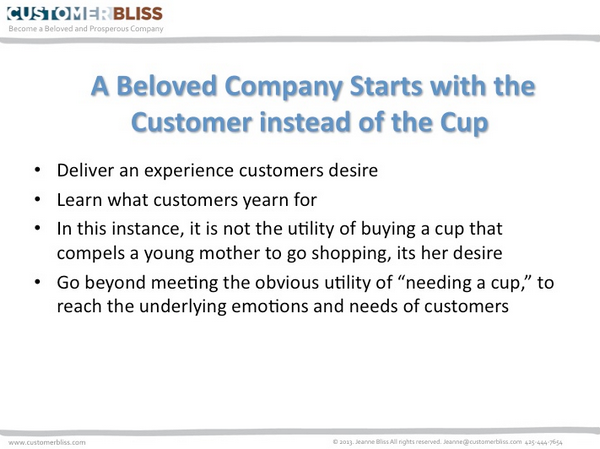This is a guest post from Jeanne Bliss — customer experience expert and author of “I Love You More Than My Dog.” See the original post this is adapted from and more like it on her blog.
The Journal of Consumer Research says in its article, “The Fire of Desire: A Multisited Inquiry in Consumer Passion,” that “there is spreading consensus that much, if not all, consumption has been quite wrongly characterized as involving need fulfillment, utility maximization, and reasoned choices.”
Think of services or experiences you’ve had that were astounding in how they impacted you.
There is a desire to repeat those experiences — most likely not only because of the utility of what was delivered, but because of how you were related to, treated, and made to feel.
Let’s say, for example, that a company is in the business of making plastic drinking cups for children. While on the surface this may sound like a trivial matter, it is not (as anyone with children knows). The right drinking cup can play a leading role in getting a child to sleep and making mealtime a relatively peaceful endeavor.
Traditional customer focus groups determine what type of cup a company should manufacture by bringing a group of customers together and placing several on the table. The facilitators ask every customer, “Which cup do you prefer?” Each customer then picks a cup. But that doesn’t mean any cup is best for them. Maybe one customer needs a cup with a straw, but the company didn’t take the time to learn about their customers’ lives. In the absence of getting what was right, customers picked what was available.
Beloved companies start with the customer instead of the cup.
They yearn to understand the emotions of the young mom who is buying the cup — to understand what solution she’d desire rather than just settle for. They learn about her life and what she needs and then build a solution from her point of view.
Product development solutions made on auto-pilot are turned on their ear when customer needs, emotions, and desires become the inspiration for product and service development. Within the beloved companies, their curiosity for understanding customer emotions in every interaction informs decision making.
As consumers, we’re conditioned to take what’s available. Beloved companies work hard every day to put a stop to that.
They go beyond executing tasks. They’re in it to deliver an experience their customers desire. Even how they learn what customers yearn for sets them apart. In this instance, it is not the utility of buying a cup that compels a young mother to go shopping; it’s her desire to help her child’s development, or to get him or her to sleep, or to not have to wipe up the floor 20 times a day.
The companies that go beyond meeting the obvious utility of “needing a cup,” as in this example, reach the underlying emotions and needs of their customers. These companies build lasting bonds with their customers. They are the ones remembered with fondness long after the children are grown, because for a period of time they were an important part of their customers’ lives.

A simple way to remember this is: the everyday company is selling cups; the beloved company is supporting parenthood.
About Jeanne Bliss
As “Chief Customer Officer” for Lands’ End, Mazda, Coldwell Banker, Allstate, and Microsoft, Jeanne got “customer” on the strategic agenda, earned 98% loyalty rates, and changed experiences across 50,000-person operations. Jeanne now runs CustomerBliss to create an actionable path for profitability and business growth -- through earning customer and employee raves. Her best-selling books are Chief Customer Officer and I Love You More than My Dog: Five Decisions that Drive
- Web |
- More Posts(64)


